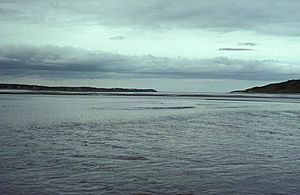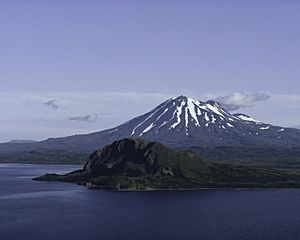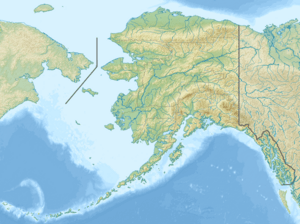Egegik River facts for kids
Quick facts for kids Egegik River |
|
|---|---|

|
|

The river begins in the Becharof National Wildlife Refuge
|
|
|
Location of the mouth of the Egegik River in Alaska
|
|
| Country | United States |
| State | Alaska |
| Borough | Lake and Peninsula |
| Physical characteristics | |
| Main source | Becharof Lake Becharof National Wildlife Refuge 14 ft (4.3 m) 58°02′25″N 156°50′26″W / 58.04028°N 156.84056°W |
| River mouth | Egegik Bay 38 miles (61 km) southwest of Naknek, Alaska Peninsula 0 ft (0 m) 58°12′19″N 157°25′07″W / 58.20528°N 157.41861°W |
| Length | 28 mi (45 km) |
The Egegik River (pronounced I-ga-gik) is a waterway in the U.S. state of Alaska. Its name, Igyagiiq, means "swift" in the Central Alaskan Yupʼik language. In 1902, a scientist named Wilfred Hudson Osgood explored the area. He studied the plants and animals around the Egegik River.
Contents
What's in a Name?
The Egegik River has had many names over time. Some old names include Ougagouk and Ugaguk. People also spelled it Igagik, Agouyak, and Ugiagik. These different names show how people from various cultures described the river.
Where is the Egegik River?
The Egegik River is found on the Alaska Peninsula. This is a long piece of land that sticks out from mainland Alaska. The river starts in the Aleutian Range mountains. It flows west from Becharof Lake into Bristol Bay. It reaches Bristol Bay through Egegik Bay, which is part of Kvichak Bay.
There are some fast-moving parts, called rapids, where the river leaves Becharof Lake. The small town of Egegik is located right at the mouth of the river. A place called White Bluff is on the north side of the river. It's near Cape Chichagof, which is on Bristol Bay.
The Egegik River has several smaller rivers that flow into it. These are called tributaries. The main tributaries are the Kejulik River, Shosky Creek, and the King Salmon River. The King Salmon River is the biggest one. It drains the land between Becharof Lake and Naknek Lake. It joins the Egegik River about 7.5 miles (12 km) from its mouth. The Becharof National Wildlife Refuge is also very close by.

The Egegik River flows for about 50 miles (80 km) from Lake Becharof. It empties into Kvichak Bay. The river's water level changes with the ocean's tides for about 25 miles (40 km) upstream. Boats can travel up the river for about 10 miles (16 km) from the lake. After that, there are many rapids. When the water is low, you can see many sandbars and narrow channels. Near the mouth, the water is shallow for several miles offshore.
Animals in the River
The Egegik River is a very important place for fish. Many types of salmon come here to lay their eggs. This is called spawning.
- Pink salmon usually spawn in August.
- Coho salmon use the main part of the river for spawning and growing up.
- Chum salmon also live in the main river.
- Arctic Char are fish that swim down the river in late May.
- Lake Trout can be found near where the river flows out of Becharof Lake.
River's History and Economy
For a long time, the Egegik River has been important for fishing. In 1895, a company called the Alaska Packers Association set up a fishing station. They used it to salt fish until 1900. Then, they moved their operations to a cannery. A cannery is a factory where fish are put into cans.
In 1899, the Alaska Packers Association built a new cannery. It was on the other side of the river from their old station. Another company, the North Alaska Salmon Company, built a cannery in 1903. Later, this company changed its name to Libby, McNeill & Libby. These canneries were about 6 miles (10 km) from the river's mouth. At this point, the river was about 2 miles (3 km) wide.
Fishermen used a method called gillnetting to catch fish. They used nets that caught fish by their gills. Fishing happened from about 3 miles (5 km) above the canneries down to the South Spit, near the river's mouth. They caught different kinds of salmon, including king salmon, dog salmon (chum salmon), and coho salmon.
In the mid-1980s, there was one fish processor on the shore in Egegik. Many other fishing stations were on boats in the river. The Egegik area had 22 floating stations. There were also 492 people with permits to use drift nets. Most of the salmon caught for personal use came from the fish caught by commercial fishermen.


